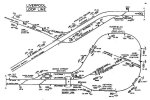12LDA28C
Established Member
I travelled this line for the first time a few days ago, and saw that the HS2 bridge works appeared to form part of a recent provision for a passing loop between Aylesbury and Little Kimble, although as far as I can find out there are no current plans to actually build this loop (maybe someone has some better info on this?).
It has been built 'future-proofed' for a doubling of the line however there are no current plans for such a doubling, or a passing loop. There were plans mooted for a passing loop at Little Kimble years ago but they came to nothing.

